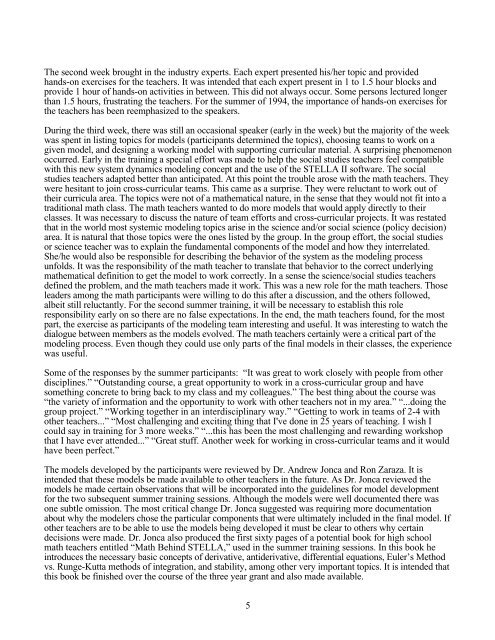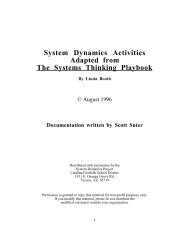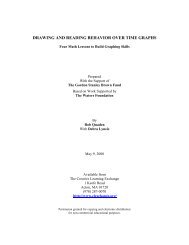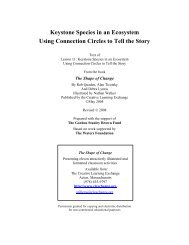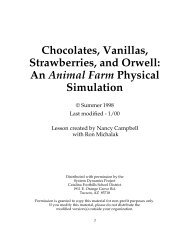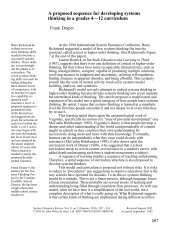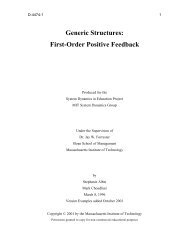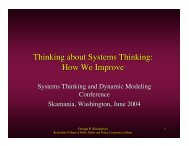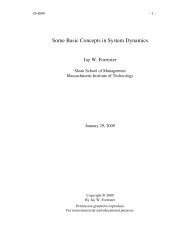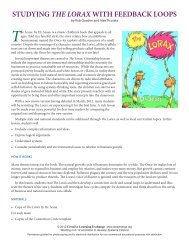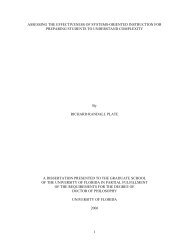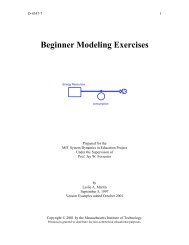Teaching System Dynamics to Teachers and Students in 8-12 ...
Teaching System Dynamics to Teachers and Students in 8-12 ...
Teaching System Dynamics to Teachers and Students in 8-12 ...
You also want an ePaper? Increase the reach of your titles
YUMPU automatically turns print PDFs into web optimized ePapers that Google loves.
The second week brought <strong>in</strong> the <strong>in</strong>dustry experts. Each expert presented his/her <strong>to</strong>pic <strong>and</strong> providedh<strong>and</strong>s-on exercises for the teachers. It was <strong>in</strong>tended that each expert present <strong>in</strong> 1 <strong>to</strong> 1.5 hour blocks <strong>and</strong>provide 1 hour of h<strong>and</strong>s-on activities <strong>in</strong> between. This did not always occur. Some persons lectured longerthan 1.5 hours, frustrat<strong>in</strong>g the teachers. For the summer of 1994, the importance of h<strong>and</strong>s-on exercises forthe teachers has been reemphasized <strong>to</strong> the speakers.Dur<strong>in</strong>g the third week, there was still an occasional speaker (early <strong>in</strong> the week) but the majority of the weekwas spent <strong>in</strong> list<strong>in</strong>g <strong>to</strong>pics for models (participants determ<strong>in</strong>ed the <strong>to</strong>pics), choos<strong>in</strong>g teams <strong>to</strong> work on agiven model, <strong>and</strong> design<strong>in</strong>g a work<strong>in</strong>g model with support<strong>in</strong>g curricular material. A surpris<strong>in</strong>g phenomenonoccurred. Early <strong>in</strong> the tra<strong>in</strong><strong>in</strong>g a special effort was made <strong>to</strong> help the social studies teachers feel compatiblewith this new system dynamics model<strong>in</strong>g concept <strong>and</strong> the use of the STELLA II software. The socialstudies teachers adapted better than anticipated. At this po<strong>in</strong>t the trouble arose with the math teachers. Theywere hesitant <strong>to</strong> jo<strong>in</strong> cross-curricular teams. This came as a surprise. They were reluctant <strong>to</strong> work out oftheir curricula area. The <strong>to</strong>pics were not of a mathematical nature, <strong>in</strong> the sense that they would not fit <strong>in</strong><strong>to</strong> atraditional math class. The math teachers wanted <strong>to</strong> do more models that would apply directly <strong>to</strong> theirclasses. It was necessary <strong>to</strong> discuss the nature of team efforts <strong>and</strong> cross-curricular projects. It was restatedthat <strong>in</strong> the world most systemic model<strong>in</strong>g <strong>to</strong>pics arise <strong>in</strong> the science <strong>and</strong>/or social science (policy decision)area. It is natural that those <strong>to</strong>pics were the ones listed by the group. In the group effort, the social studiesor science teacher was <strong>to</strong> expla<strong>in</strong> the fundamental components of the model <strong>and</strong> how they <strong>in</strong>terrelated.She/he would also be responsible for describ<strong>in</strong>g the behavior of the system as the model<strong>in</strong>g processunfolds. It was the responsibility of the math teacher <strong>to</strong> translate that behavior <strong>to</strong> the correct underly<strong>in</strong>gmathematical def<strong>in</strong>ition <strong>to</strong> get the model <strong>to</strong> work correctly. In a sense the science/social studies teachersdef<strong>in</strong>ed the problem, <strong>and</strong> the math teachers made it work. This was a new role for the math teachers. Thoseleaders among the math participants were will<strong>in</strong>g <strong>to</strong> do this after a discussion, <strong>and</strong> the others followed,albeit still reluctantly. For the second summer tra<strong>in</strong><strong>in</strong>g, it will be necessary <strong>to</strong> establish this roleresponsibility early on so there are no false expectations. In the end, the math teachers found, for the mostpart, the exercise as participants of the model<strong>in</strong>g team <strong>in</strong>terest<strong>in</strong>g <strong>and</strong> useful. It was <strong>in</strong>terest<strong>in</strong>g <strong>to</strong> watch thedialogue between members as the models evolved. The math teachers certa<strong>in</strong>ly were a critical part of themodel<strong>in</strong>g process. Even though they could use only parts of the f<strong>in</strong>al models <strong>in</strong> their classes, the experiencewas useful.Some of the responses by the summer participants: “It was great <strong>to</strong> work closely with people from otherdiscipl<strong>in</strong>es.” “Outst<strong>and</strong><strong>in</strong>g course, a great opportunity <strong>to</strong> work <strong>in</strong> a cross-curricular group <strong>and</strong> havesometh<strong>in</strong>g concrete <strong>to</strong> br<strong>in</strong>g back <strong>to</strong> my class <strong>and</strong> my colleagues.” The best th<strong>in</strong>g about the course was“the variety of <strong>in</strong>formation <strong>and</strong> the opportunity <strong>to</strong> work with other teachers not <strong>in</strong> my area.” “...do<strong>in</strong>g thegroup project.” “Work<strong>in</strong>g <strong>to</strong>gether <strong>in</strong> an <strong>in</strong>terdiscipl<strong>in</strong>ary way.” “Gett<strong>in</strong>g <strong>to</strong> work <strong>in</strong> teams of 2-4 withother teachers...” “Most challeng<strong>in</strong>g <strong>and</strong> excit<strong>in</strong>g th<strong>in</strong>g that I've done <strong>in</strong> 25 years of teach<strong>in</strong>g. I wish Icould say <strong>in</strong> tra<strong>in</strong><strong>in</strong>g for 3 more weeks.” “...this has been the most challeng<strong>in</strong>g <strong>and</strong> reward<strong>in</strong>g workshopthat I have ever attended...” “Great stuff. Another week for work<strong>in</strong>g <strong>in</strong> cross-curricular teams <strong>and</strong> it wouldhave been perfect.”The models developed by the participants were reviewed by Dr. Andrew Jonca <strong>and</strong> Ron Zaraza. It is<strong>in</strong>tended that these models be made available <strong>to</strong> other teachers <strong>in</strong> the future. As Dr. Jonca reviewed themodels he made certa<strong>in</strong> observations that will be <strong>in</strong>corporated <strong>in</strong><strong>to</strong> the guidel<strong>in</strong>es for model developmentfor the two subsequent summer tra<strong>in</strong><strong>in</strong>g sessions. Although the models were well documented there wasone subtle omission. The most critical change Dr. Jonca suggested was requir<strong>in</strong>g more documentationabout why the modelers chose the particular components that were ultimately <strong>in</strong>cluded <strong>in</strong> the f<strong>in</strong>al model. Ifother teachers are <strong>to</strong> be able <strong>to</strong> use the models be<strong>in</strong>g developed it must be clear <strong>to</strong> others why certa<strong>in</strong>decisions were made. Dr. Jonca also produced the first sixty pages of a potential book for high schoolmath teachers entitled “Math Beh<strong>in</strong>d STELLA,” used <strong>in</strong> the summer tra<strong>in</strong><strong>in</strong>g sessions. In this book he<strong>in</strong>troduces the necessary basic concepts of derivative, antiderivative, differential equations, Euler’s Methodvs. Runge-Kutta methods of <strong>in</strong>tegration, <strong>and</strong> stability, among other very important <strong>to</strong>pics. It is <strong>in</strong>tended thatthis book be f<strong>in</strong>ished over the course of the three year grant <strong>and</strong> also made available.5


